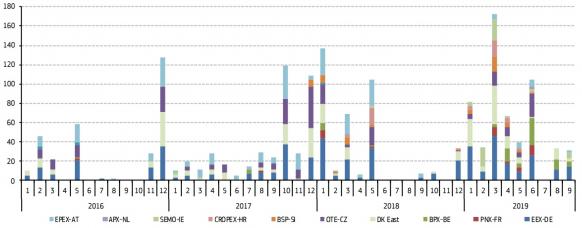Wind utilities accelerate shift to spot price maintenance
Wind-thirsty utilities are taking greater control of operations, accelerating a move towards wholesale-linked maintenance strategies and wind-storage revenues, leading groups told the Wind Operations Europe 2020 conference.

Related Articles
A renewables drive by European utilities is set to spur advances in wind operations and maintenance (O&M) practices in the coming years.
Growing renewable energy capacity is lowering wholesale prices across Europe and the removal of wind subsidies will put increasing pressure on operational efficiency.
Competition between service providers has sliced O&M prices. Larger asset owners are bringing O&M activities in-house and building analytics capabilities to maximize economies of scale.
As exposure to wholesale markets grows, wind O&M strategies will need to focus on realized market value to optimize price swings, leading utility operators told the conference in Munich on March 5.
Wind operators have been shifting from time-based availability contracts to production-based contracts, but a further step is needed, experts said.
Germany's RWE Renewables is looking to move away from time and production-based availability metrics towards market value-based metrics, Roland Flaig, Head of Wind Operations, EU North at RWE, told attendees.
"Every kilowatt-hour is not equally valuable," Flaig said.
"We want a certain kind of megawatt-hours or kilowatt-hours in the future," he said.
Price volatility
With decades of power generation experience, utilities are well-versed in wholesale market operations.
RWE currently operates 9 GW of global renewable energy capacity and has around 2.6 GW under construction.
The hazards of growing wind capacity were illustrated earlier this year when strong wind in Northern Europe boosted production but also depressed prices, Flaig told the conference.
"You are happy about the kilowatts hours that you deliver but not so happy when you see what you get," he said.
"Even if you have hedging regimes...for the overproduction you get paid on market prices."
Number of negative hourly power prices on European markets
(Click image to enlarge)
Source: European Commission's Quarterly Electricity Market Report, Q3 2019.
Swedish utility Vattenfall is taking greater operational control of its wind fleet and last year switched to revenue-based availability as one of its "leading" key performance indicators, Anna Jasper-Martens Director of Business Excellence & Asset Management at Vattenfall, said.
A leading offshore wind developer, Vattenfall currently operates around 1.5 GW of onshore wind capacity in Europe and is building a further 1 GW. Vattenfall operates wind assets in Sweden, Denmark, Netherlands, UK and Germany and these markets have already seen long periods of low or negative prices, Jasper-Martens said.
"So this was a necessity for us to implement this," she said.
Owner control
In the O&M market, original equipment manufacturers (OEMs) have faced increasing competition from independent service providers (ISPs) and operators' in-house O&M teams.
Portuguese utility EDP Renewables (EDPR) has built up its in-house operational expertise to improve the yield on its 11 GW of global wind assets.
"We believe that to maximize the value of the asset, the operator or owner needs to take the lead on the operation," David Talavan, Central Asset Operations Director, EU at EDPR, told the conference.
"We are working with full service [contracts] only for the first two years of warranty, after that we [move] to a flexible model," he said.
Under the flexible model, activities such as performance and maintenance management and remote operations are brought in-house, while other activities are outsourced to independent service providers, Talavan said.
In-house control of the supply chain for main components is also key to reducing replacement times and costs, he added.
Spare parts costs can represent up to half of O&M costs and larger service groups have expanded spare parts infrastructure and analytics coverage to increase efficiency.
Data costs
At Vattenfall, greater control of operations means building new analytics capabilities.
"The implementation of that is the topic that is driving us at the moment…We are building up our technical, specialist and analytical capabilities,” Jasper-Martens said.
Cost-effective investment is key, Jasper-Martens noted.
"We are entering this terrain... We are building up our financial models to find the right balance," she said.
Turbine supplier Nordex has been building its predictive capabilities for the last few years and can predict faults such as a main bearing failure a year in advance, Christian Busdiecker, Head of Service, Europe at Nordex, said.
"That's really helpful, specifically in markets where there are big machines with high towers, high crane costs-- that really brings the cost down," he said.
Due to the investment required, larger companies are better positioned to invest in analytics capabilities, Busdiecker noted.
New uses
Low wholesale prices will have a greater impact on asset owners when wind subsidies are removed, operators warned.
"We have to learn how to produce when it's valuable to produce," Flaig said.
"We will have to become more like a hydro plant...We will have to find a way to mix our wind assets with storage assets," he said.
UK utility ScottishPower is currently building a 50 MW lithium ion battery facility at its Whitelee wind farm in Scotland. ScottishPower recently became the first UK utility to generate 100% of its electricity from wind and reportedly plans to build at least six energy storage projects by the end of 2020.
As renewable capacity grows, wind operators must plan for times when there is no grid demand and look into new energy storage solutions and other demand sources such as the emerging renewable hydrogen market, Talavan said.
A lack of system demand "could be a challenge for all of us," he said.
Robin Sayles

